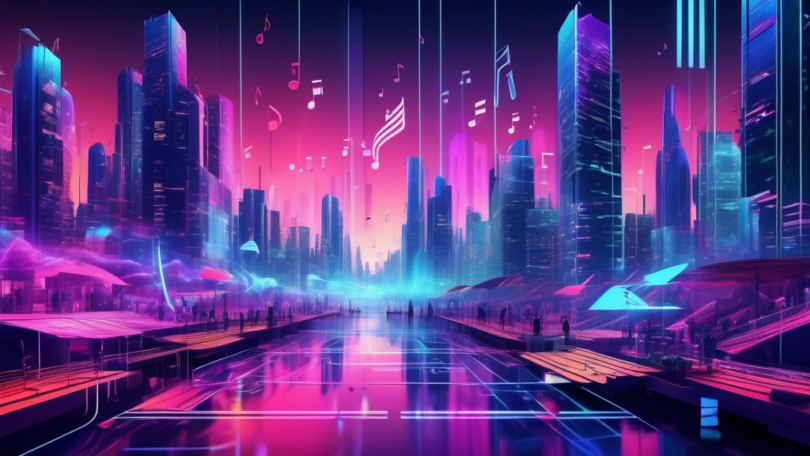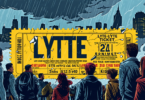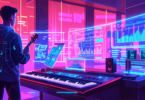In the fast-evolving landscape of the music industry, the advent of artificial intelligence (AI) has ushered in a new era of possibilities and challenges. Among the many facets of this industry that are being transformed, sync licensing stands out as a critical area where the balance between innovation and artistic integrity must be carefully managed. Sync licensing, which involves the use of a piece of music in conjunction with visual media such as films, television shows, advertisements, and video games, plays a significant role in the revenue streams and exposure of artists today.
At its core, sync licensing is a multifaceted process that requires meticulous coordination between various stakeholders, including artists, licensing agencies, and content creators. Its importance cannot be overstated, given that a well-placed track can enhance the emotional impact of visual media and bring music to new audiences. However, the rising wave of AI technologies is revolutionizing this domain, offering unprecedented efficiencies and opportunities.
AI technologies are transforming how music is created, discovered, and licensed. From AI-powered music composition tools that can generate tracks in various styles to sophisticated algorithms that match songs to visual content with high precision, the music and media industries are embracing these advancements. But with this embrace comes a pressing need to ensure that the essence of human creativity and the integrity of artistic works are not overshadowed by the pursuit of technological progress.
Striking a balance between innovation and artistic integrity is crucial. On one hand, AI can significantly streamline the sync licensing workflow, making it easier and faster for all parties involved. For artists, this means potentially greater access to licensing opportunities and new audiences. Licensing agencies and content creators can benefit from enhanced capabilities in finding the perfect musical accompaniment to their visual projects. However, these technologies also raise important questions about the role of human creativity and the authenticity of art in an age increasingly dominated by algorithms and machine learning.
As we delve deeper into this synergy of sync licensing and AI, it becomes essential to consider not only the technological advancements but also the ethical implications and potential risks. The challenge lies in leveraging the benefits of AI to enhance the sync licensing process while safeguarding the intrinsic value of human creativity. Through thoughtful strategies and a commitment to upholding artistic values, it is possible to navigate this complex landscape and ensure that innovation complements rather than compromises artistic integrity.
Explanation of Sync Licensing and Its Significance in Today’s Music Industry
Sync licensing, short for synchronization licensing, involves the legal agreement that permits copyrighted music to be used in media content such as films, television shows, advertisements, and video games. This type of licensing gains its name from the synchronization of music with visual media, creating a cohesive and often emotionally resonant end-product. The process not only generates substantial revenue for musicians and composers but also offers invaluable exposure. In an age where media consumption is skyrocketing, sync licensing has become a bedrock of the music industry.
For musicians, sync licensing serves as a double-edged sword. On the one hand, it offers financial stability in an era where digital streams might not necessarily translate into significant income. On the other, it provides global exposure, instantly reaching millions and cementing a track’s place in popular culture. Notably, sync placements in high-profile projects can catapult a virtually unknown artist to stardom overnight.
AI Technologies Revolutionizing Music and Media
Artificial Intelligence (AI) is an umbrella term encapsulating a multitude of technologies that imitate human intelligence processes. In the music and media industries, AI has manifested in various forms such as machine learning, neural networks, and natural language processing. AI’s applications span from content creation to data analysis, making it an indispensable tool in today’s digital landscape.
Among the groundbreaking uses of AI in music is its ability to compose and produce music autonomously. AI algorithms can analyze vast datasets of existing songs to understand genre-specific elements, subsequently composing original music that adheres to those stylistic guidelines. Companies like OpenAI, Jukedeck, and Amper Music have made impressive strides in this space, creating AI systems that can generate music tailored to specific moods, settings, and thematic requirements.
In the realm of sync licensing, AI-powered metadata tagging and content recognition technologies enhance the efficiency of finding the right music for a particular visual piece. AI can also predict music trends, helping music supervisors make informed decisions about song placements that would resonate with contemporary audiences. This revolution, however, doesn’t come without challenges.
Importance of Finding a Balance Between Innovation and Preserving Artistic Integrity
As AI continues to transform the music industry, blending creativity with computational prowess, it brings forth the critical issue of artistic integrity. The term artistic integrity refers to the authenticity and originality of creative works, reflecting the personal touch, cultural significance, and innovative spirit of the artist.
Striking a balance between harnessing AI’s potential and preserving artistic integrity is paramount. On one side, AI can democratize music production by lowering barriers to entry. It provides independent artists and small content creators with the tools to produce high-quality music without necessitating expensive equipment and extensive musical training. To illustrate, an indie filmmaker can use AI-generated music in their project, thereby saving costs and avoiding lengthy delays typically associated with traditional sync licensing.
However, equating AI-generated music to compositions birthed from human intellect and emotion can present ethical quandaries. An AI system lacks intrinsic creativity, emotional depth, and cultural awareness—all of which are cornerstones of genuine artistry. Therefore, while AI can assist, streamline, and enhance, it must not eclipse the value of human creativity and expression.
Moreover, the over-reliance on AI-generated content might foster a homogenization of music, yielding a landscape where creativity is synonymous with algorithmic predictability rather than innovation. For an industry that thrives on diversity, innovation, and the fusion of different cultural influences, this presents a significant risk. Content that marginally diverges from established patterns may be overlooked, stunting the evolution of musical genres.
Thus, while AI continues to offer substantial improvements in efficiency and accessibility, stakeholders within the music industry must foster practices that prioritize and cherish human artistry. Integrating AI into the creative process should be akin to providing artists with new tools and canvases, rather than replacing the artists themselves. By maintaining this balance, it is possible to leverage the advantages of AI while ensuring the preservation and celebration of genuine creativity.
Impact of AI on Sync Licensing Processes
The intersection of artificial intelligence (AI) and sync licensing has brought about a significant transformation in the music industry. These advancements are streamlining the sync licensing workflow, providing numerous benefits to artists, licensing agencies, and content creators. Understanding these impacts illuminates the ways technology is enhancing efficiency and opening up new opportunities within the industry.
AI is Streamlining the Sync Licensing Workflow
AI technologies have fundamentally redefined the sync licensing process by automating and optimizing several key functions. Historically, sync licensing has been a labor-intensive task, entailing manual negotiations, extensive research, and rigorous compliance checks. AI algorithms, however, are revolutionizing these stages:
- Music Catalog Management: AI-driven platforms can sift through vast libraries of music tracks at lightning speed, categorizing them based on mood, genre, tempo, and other intricate parameters. This functionality markedly shortens the time required for music supervisors to find the perfect track.
- License Pricing: Traditionally, pricing a sync license involves negotiating with multiple stakeholders and interpreting market trends. AI systems can analyze historical data and current market conditions to suggest optimal pricing strategies, ensuring both fair compensation for artists and budget compliance for content creators.
- Negotiation and Compliance: AI tools can aid in drafting and evaluating contracts, ensuring they meet all legal and regulatory requirements. They can also flag potential issues before they become problematic, facilitating a smoother negotiation process.
- Rights Management: AI technologies can automate the tracking of complex rights and royalties, ensuring that all involved parties receive their due compensation on time and with transparency.
Benefits of AI for Artists, Licensing Agencies, and Content Creators
The implementation of AI in sync licensing offers considerable advantages across the board:
For Artists
AI tools provide artists with unparalleled exposure. Automated systems can match an artist’s work with potential licensees more efficiently than ever before, increasing the chances of their music being selected for various media projects. Additionally, AI algorithms can recommend strategies for artists to diversify their portfolios, ensuring their music reaches a broader audience.
For Licensing Agencies
Agencies tasked with representing artists and their work benefit significantly from AI’s analytical capabilities. These systems can generate insights into market trends, enabling agencies to strategically position their catalogs. Furthermore, automated administrative processes reduce overhead, enabling agencies to focus more on client relationships and creative pursuits.
For Content Creators
Content creators, seeking the perfect soundtrack for their projects, save both time and resources through AI-enhanced search and match functionalities. These technologies can provide more accurate music suggestions that align with the creators’ specific needs, thereby elevating the overall quality of the content produced.
Case Studies or Examples of Successful AI Integration in Sync Licensing
Example 1: AIVA Technologies
AIVA Technologies, an AI music composition platform, partners with sync licensing agencies to generate bespoke music scores. The company uses deep learning algorithms to analyze existing music and compose original tracks. Their integration into the sync licensing workflow allows for rapid creation and iteration of music pieces tailored to specific briefs, dramatically reducing turnaround times.
Example 2: Jukedeck
Jukedeck, acquired by TikTok, exemplifies how AI can create original music at scale. The platform allows content creators to specify the type of music they need—mood, style, duration—and the AI system composes a custom track. This capability has empowered independent content creators by providing accessible, affordable music that can be easily licensed.
Example 3: Amper Music
Amper Music’s AI composer collaborates with artists to co-create music. By integrating into the sync licensing process, Amper’s technology provides immediate feedback and suggestions, aligning compositions with the specific requirements of projects. This has opened up new opportunities for artists to adapt their work to a diverse array of sync uses efficiently.
In conclusion, the impact of AI on sync licensing processes is both profound and multifaceted. By streamlining workflows, offering enhanced efficiency, and providing tailored solutions, AI is not just a catalyst for innovation but also a valuable asset for all stakeholders involved in the music industry. As these technologies continue to evolve, they promise to bring even greater advancements and opportunities, ensuring that the balance between innovation and artistic integrity is maintained.
Challenges and Ethical Considerations in AI-Driven Sync Licensing
The integration of artificial intelligence (AI) in the sync licensing industry has brought forward several challenges and ethical complications, especially concerning the preservation of artistic integrity and creativity. As the technology evolves, the industry faces potential risks that necessitate strategic navigation to maintain a balanced approach.
Potential Risks to Artistic Integrity and Creativity
One of the primary concerns surrounding AI-driven sync licensing is the potential dilution of artistic integrity. AI systems, while extraordinarily proficient at analyzing data and identifying patterns, may inadvertently favor formulaic approaches that prioritize commercial viability over genuine creativity.
For instance, AI algorithms can recommend tracks that match specific commercial criteria, potentially sidelining unique or unconventional pieces of music that do not fit the mold. This could stifle innovation, leading to a homogenized musical landscape where only particular styles and genres are favored for sync deals. Moreover, AI’s capability to generate music autonomously introduces questions about the originality and authenticity of such compositions. Should a track created entirely by AI be considered a work of art in the same vein as one composed by a human artist?
Ethical Dilemmas and Legal Implications
The ethical landscape of AI-driven sync licensing presents numerous dilemmas. One significant issue is the question of authorship: If an AI-assisted tool helps create a piece of music, who holds the authorship rights? Is it the musician who inputted the initial data, the AI developer, or the corporation that owns the technology?
Moreover, there is a potential for bias in AI algorithms, which are only as objective as the data fed into them. AI systems trained on biased datasets can inadvertently reinforce existing biases in music selection, disadvantaging marginalized groups and lesser-known artists. This can create an inequitable environment, where only those who conform to certain prevalent trends benefit from sync licensing opportunities.
From a legal perspective, there are unresolved issues about copyright laws and intellectual property. Current copyright laws are primarily structured around human creativity. However, as AI increasingly participates in the creation of music, legislative bodies will need to adapt and create frameworks that address the complexities introduced by AI creations. This includes determining ownership rights and ensuring fair compensation for all parties involved.
Strategies for Maintaining Balance Between AI Advancements and Artistic Values
Maintaining a balance between leveraging AI’s capabilities and upholding artistic values requires a multifaceted approach. Industry stakeholders must develop thoughtful strategies to navigate these emerging issues effectively.
- Transparent Algorithms: Ensuring that AI algorithms are transparent and explainable is crucial. This means developing systems where the decision-making processes are understandable to users, making it easier to identify and rectify potential biases.
- Diverse Data Sets: To counteract biases, using diverse and representative datasets for training AI models is essential. This can help ensure a fairer and more inclusive selection process that recognizes and values a wide array of musical styles and backgrounds.
- Human Oversight: Incorporating human oversight into the AI-driven sync licensing workflow is vital. While AI can provide valuable insights and streamline processes, human judgment is necessary to evaluate the artistic merit of compositions and make final decisions that respect artistic integrity.
- Fair Compensation Models: Creating compensation models that fairly distribute revenue from AI-generated music is important. This might involve new licensing agreements that recognize the contributions of both human creators and AI technologies.
- Ethical Guidelines: The development of comprehensive ethical guidelines and standards for AI use in the music industry can help ensure responsible practices. These guidelines should be developed collaboratively by a broad range of stakeholders, including artists, technologists, legal experts, and industry leaders.
The balance of innovation and artistic integrity in the era of AI-driven sync licensing is a delicate one. With the right strategies and a commitment to ethical practices, the music industry can harness the advantages of AI while preserving the creative essence that forms the heart of musical expression.
Balancing innovation with artistic integrity in the realm of sync licensing has never been more crucial than in the AI era. As we navigate through an increasingly technological landscape, the role of artificial intelligence in streamlining sync licensing processes offers both immense opportunities and complex challenges. The integration of AI in these workflows has proven to be a double-edged sword, enhancing efficiency and accessibility while simultaneously posing risks to the creative essence that defines music.
AI’s capability to quicken the sync licensing process has undeniably transformed the industry. Artists, licensing agencies, and content creators benefit from expedited workflows, which facilitate quicker decision-making and broaden the horizon for creative collaborations. Case studies have shown how AI can match music with visual media in innovative ways, providing a seamless experience that would have been arduous to achieve manually. These technological advancements have the potential to democratize access to sync opportunities, enabling a wider array of artists to showcase their work to expansive audiences.
However, this expedited landscape is not without its ethical dilemmas and challenges. One of the most poignant concerns is preserving the artistic integrity that AI processes often seem to overlook. The risk of commodifying art, transforming it into mere data points, looms large, raising questions about the authenticity and emotional depth AI-driven processes can deliver. Additionally, the use of AI can sometimes bypass the nuanced human touch that identifies the unique elements of a piece of music, resulting in choices that may not fully encapsulate the artist’s intended expression.
The legal implications of AI in sync licensing add another layer of complexity. Ownership rights, royalties, and the ethical handling of creative content necessitate rigorous oversight to ensure artists are fairly compensated and their work is respected. Thus, a robust legal framework needs to be in place, providing clear guidelines on the application of AI in the sync licensing domain, ensuring it does not exploit creators but rather supports and amplifies their work.
Moving forward, it is essential to adopt a balanced approach that leverages AI’s capabilities while firmly grounding actions in a respect for artistic integrity. Strategies such as involving human oversight in the AI-driven processes, developing AI systems that are transparent and easily regulatable, and fostering a collaborative environment between technologists and artists can facilitate this balance. By doing so, the music industry can harness the power of AI to innovate and grow without losing sight of the core values that celebrate and uphold the artistry at the heart of music.
Ultimately, the successful integration of AI in sync licensing will depend on ongoing dialogue and collaboration among all stakeholders. Embracing technological progress while safeguarding the creative spirit requires continuous effort, adaptive strategies, and a shared commitment to both innovation and artistic fidelity. In striking this delicate balance, we can look forward to a future where technology enhances rather than overshadows the artistry that sync licensing aims to celebrate and proliferate.








